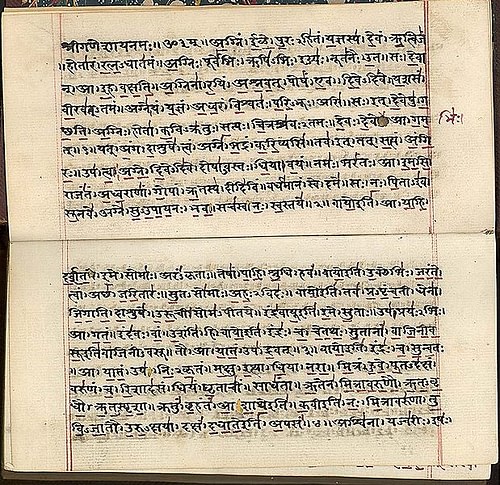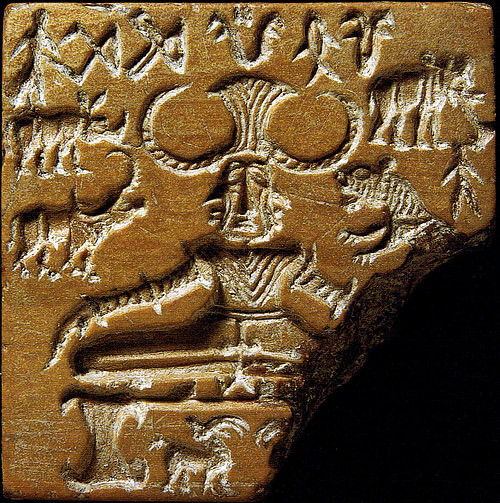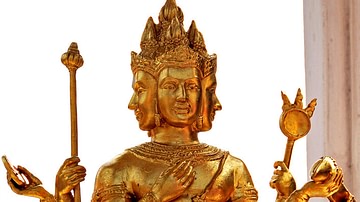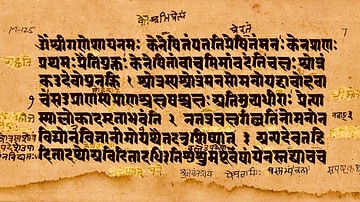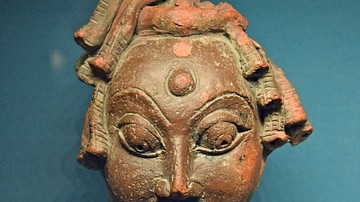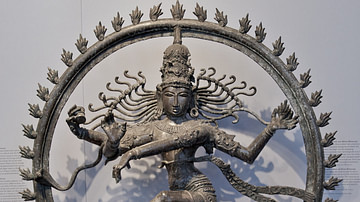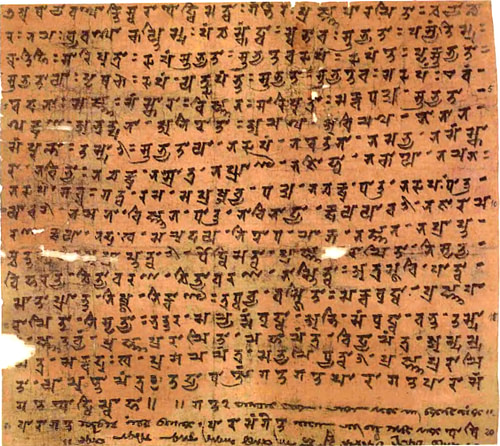
Sanskrit is regarded as the ancient language in Hinduism, where it was used as a means of communication and dialogue by the Hindu Celestial Gods, and then by the Indo-Aryans. Sanskrit is also widely used in Jainism, Buddhism, and Sikhism. The term 'Sanskrit' is derived from the conjoining of the prefix 'Sam' meaning 'samyak' which indicates 'entirely', and 'krit' that indicates 'done'. Thus, the name indicates perfectly or entirely done in terms of communication, reading, hearing, and the use of vocabulary to transcend and express an emotion. An extraordinarily complex language with a vast vocabulary, it is still widely used today in the reading of sacred texts and hymns.
Origin & purity of Sanskrit
The Sanskrit language was termed as Deva-Vani ('Deva' Gods - 'Vani' language) as it was believed to have been generated by the god Brahma who passed it to the Rishis (sages) living in celestial abodes, who then communicated the same to their earthly disciples from where it spread on earth. The origin of the language in written form is traced back to the 2nd millennium BCE when the Rig Veda, a collection of sacred hymns, is assumed to have been written after being continued for centuries through oral tradition and preservation of verbal knowledge in the Guru-Disciple relationship. The purity of this version (Vedic period, 1500 – 500 BCE) of Sanskrit is doubtlessly reflected in the flamboyance of the perfect description of the forces of nature in the Rig Veda.
Vedic Sanskrit
Sanskrit in terms of its literary association is classified into two different periods, the Vedic and Classical. Vedic Sanskrit is found in the Vedas sacred texts, especially the Rig Veda, the Puranas, and the Upanishads, where the most original form of the language was used. The composition of the Vedas is traced to the period of 1000 to 500 BCE, until when Sanskrit had a vigorous tradition of being used consistently through oral communication. This early Sanskrit is rich in vocabulary, phonology, grammar, and syntax, which remains undiluted in its purity to this day. It consists of 52 letters in total, 16 vowels and 36 consonants. These 52 letters have never been tweaked or altered and are believed to have been constant since the beginning, thus making it the most perfect language for word formation and pronunciation.
The Sanskrit language has been the traditional means of communication in Hinduism, Jainism, Buddhism, and Sikhism. Sanskrit literature holds the privilege of being used in ancient poetry, drama, and sciences, as well as religious and philosophical texts. The language is believed to have been generated by observing the natural progression of sounds created in the human mouth, thus considering sound as an important element of language formation. This is one of the prime reasons why Sanskrit has been rich in poetry and its expressive quality of bringing out the best meaning through perfect sounds that are soothing to the human ear. Vedic Sanskrit also contains abstract nouns and philosophical terms which are not to be found in any other language. The consonants and vowels are flexible enough to be grouped together to express nuanced ideas. In all, the language is like an endless ocean without a base due to its reach, complexity, and hundreds of words to express a single meaning or object.
Classical Sanskrit - AshtadhYayi
Classical Sanskrit has its origin in the end of the Vedic period when the Upanishads were the last sacred texts to be written down, after which Panini, a descendant of Pani and a grammar and linguistic researcher, introduced the refined version of the language. Panini's timeline is assumed to be around the 4th century BCE, when he introduced his work 'Ashtadhyayi', which means eight chapters, forming the only available foundational and analytical text of Sanskrit grammar. It is considered to be the only source of Sanskrit grammar and vocabulary today, because everything that existed before had never been recorded except via their mention in Panini's Ashtadhyayi.
The Ashtadhyayi contains 3959 systematised rules that are undiluted in brevity, full of wonderful analysis, explanation, and preferential usage of the language and word formation. The language is so vast that it has more than 250 words to describe rainfall, 67 words to describe water, and 65 words to describe earth, among other descriptions. This proves the magnanimity of Sanskrit when compared with current modern languages. However, different the sub-castes of Hinduism may be in their dialect, race, creed and rank, Sanskrit is considered and accepted as the only sacred language giving rise to the only available sacred literature by all, even though India has a repository of 5000 spoken languages. Panini was responsible for the standardisation of the language, which to this day remains in use in multiple forms. Sanskrit as a spoken language is rare and is spoken in some regions in India, some even claiming it as their first language, but it is proudly mentioned as one of the 14 original languages of India in its Constitution. It is largely used in Carnatic music in the form of bhajans, shlokas, stotras, and kirtanas, all indicating various hymns to the Gods, and songs and mantras of God worship.
Impact on other languages
Sanskrit has had a major impact on other Indian languages, such as Hindi, which is presently one of the official languages of India, and Indo-Aryan languages such as Kannada and Malayalam. It has impacted the Sino-Tibetan languages with the influence of Buddhist texts in Sanskrit and their translation and spread. Telugu as a language is considered to be highly lexically Sanskrit, from which it has borrowed many words. It has impacted Chinese language as China has picked up multiple but specific words from Sanskrit. In addition, Thailand and Sri Lanka has been enormously influenced by Sanskrit and have many similarly sounding words. The Javanese language is another which has been influenced by Sanskrit, along with the modern language of Indonesia and traditional language of malay spoken in Malaysia. Philippines has a minor influence from Sanskrit, but less than that from Spanish, for example. Above all, English, the current modern international language has also been influenced by Sanskrit and has picked up many loanwords from the ancient language (for example 'primitive' from 'prachin', meaning historical, 'ambrosia' from 'amaruta' meaning food of the Gods, 'attack' from 'akramana' meaning taking aggressive action, 'path' from 'patha' meaning road or way, 'man' from 'manu' meaning a male human, 'nirvana' from 'nirvan' meaning divine liberation or transcendence, 'door' from 'dwar' meaning a doorway connecting two spaces, ''serpent' from 'sarpa' meaning snake, etc.) since both are considered as Indo-European languages.
Sanskrit has a long and sacred history often traced back to the Gods and their worship. Starting as a spoken language of the Gods, it has come down to earth and has been diluted of its purity because variable interpretations, precise grammar, and complexity of its use have been accepted by few and avoided by many for its invincibility in vastness and understanding. In spite of its large vocabulary and richness of grammar and prose, many ancient scriptures and texts today are translated from Sanskrit, for none better than Sanskrit can offer such a luxurious literary understanding of the past as it serves as a tool for perfect human expression. Rightfully admired, renowned historian and author William Cooke Taylor acknowledges that “To acquire the mastery of this language is almost a labour of a life; its literature seems exhaustless”.
